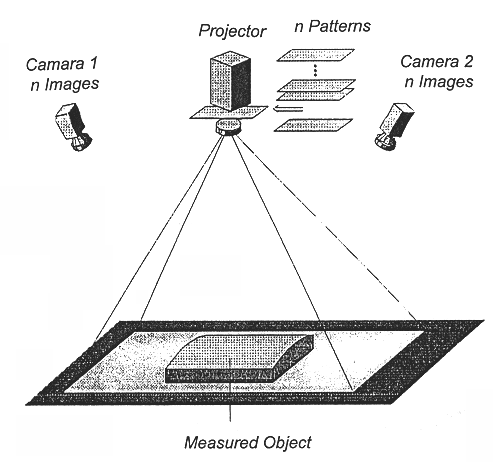Method of three-dimensionally measuring object surfaces
a three-dimensional measurement and object technology, applied in the field of three-dimensional measurement of object surfaces, can solve the problems of affecting the accuracy of the measurement, so as to achieve the effect of low degree of uncertainty of measurement and high resolution
- Summary
- Abstract
- Description
- Claims
- Application Information
AI Technical Summary
Benefits of technology
Problems solved by technology
Method used
Image
Examples
example 2
Approximation of the Surface by an Approximation Point Based Upon a Directional Vector.
In certain applications it is desirable to perform the iterative 3D measurement vertically relative to the expected surface of the measured object or in a predetermined defined direction within space (FIG. 7). The reason for it usually is the result of routines for the further processing of the "cloud" of 3D points in which data measured in this fashion is required for further processing.
To realize this requirement, iterative shifting of the approximation point is performed along a straight line in space, the position of which may be vectorially defined (FIG. 6). To this end the so-called point-direction-form may be used:
X=X.sub.0 +t.multidot..DELTA.X
Y=Y.sub.0 +t.multidot..DELTA.Y
Z=Z.sub.0 +t.multidot..DELTA.Z
wherein:
X Y, Z are coordinates of a point on a straight line in space
t; parameter for determining the point on the straight line in space
X.sub.0, Y.sub.0, Z.sub.0 are coordinates of the base ...
example 1
projection of the spatial point onto both sensor surfaces;
associating the grey value sequence to the projection points p' and p" (FIG. 7);
search for the correlation maximum by a gradient slope process.
However, in a directionally based measurement the parameter t forms the basis of the iterative approximation. Changing this parameter causes the approximation point to shift along the set straight line in space. This is a broadening of the method limited to a measurement vertically of the XY plane of the spatial coordinate system. It makes possible iteratively to determine, in a manner similar to the gradient slope process (as in Example 1), the point which may be interpreted as the point at which the straight spatial line penetrates through the surface of the measured object. Example 3
Approximation of the Surface by 3.times.3 Spatial Points
In this example 3.times.3 spatial points are used for approximating the surface. The reason for doing it is the desire to decrease the statistical ...
PUM
 Login to View More
Login to View More Abstract
Description
Claims
Application Information
 Login to View More
Login to View More - R&D
- Intellectual Property
- Life Sciences
- Materials
- Tech Scout
- Unparalleled Data Quality
- Higher Quality Content
- 60% Fewer Hallucinations
Browse by: Latest US Patents, China's latest patents, Technical Efficacy Thesaurus, Application Domain, Technology Topic, Popular Technical Reports.
© 2025 PatSnap. All rights reserved.Legal|Privacy policy|Modern Slavery Act Transparency Statement|Sitemap|About US| Contact US: help@patsnap.com

